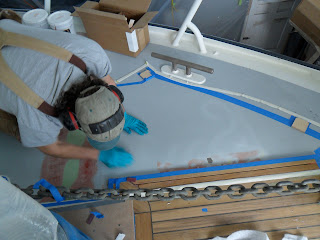Well known Canadian boat designer and nautical sage, Francis Fredette built Pescawa in Esquimalt Harbor on a scow barge in 1939 for himself. Fredette with a long and storied life spent much of his days seeing the world by water. It's easy to be charmed by the story of this man. It begins having been both lured into and warned off by the romance of maritime life by a favorite uncle. After his first adventure as a cabin boy on a sealing vessel, his father recognized his seamanship proclivity and aptitude, allowing him to become an apprentice shipwright rather then pursuing scholastics. He made steady progress learning the trade. Eventually economic hardship forced him to leave Victoria following work fishing cod, more sealing, building Bristol Bay boats in Seattle, and a stint in the Merchant Marines during WW1.
 |
| Just before the journey to Emerald Marine |
Among his adventures, Fredette, being dedicated to correct maritime conduct, clandestinely escaped a nasty Captain and murderous first mate. Later, as part of a hardy crew, he survived with 32 others on a life boat for 24 days after a lightening strike turned one ship into a floating bomb. The men washed ashore in the Philippines. When he recovered his health he returned home to his family who had heard of no survivors from the lost ship, and took him for lost. Pescawa was to be a turn of career for Fredette. Equipped with the lore and support of fellow fishermen he decided to try his hand at harvesting from the sea.
After a brief, unsuccessful foray into fishing, Francis sold the boat and went back to building and designing. His wife Irene had strongly encouraged him to pursue his creative talent. He has many designs to his credit: pelagic sealing boats, yachts, handy day sailers, fishing vessels and cruisers. Near the end of his career he encouraged the shipwright skills in others and trained green shipwrights in Nanaimo.
 |
| Aft shot of the 'cruising stern' |
Pescawa's most unique aspect is what Fredette named a cruising stern: a combination of a double ended and a round stern. It is built both staved and in lifts to form a rounded canoe-like stern. This particular design was later used by designer Edwin Monk. Pescawa's owner, David Waterman feels strongly about preserving this salty boat so rich in personal history for Fredette.
While the boat was in Dave's back yard he painstakingly removed the foamed in fish hold, tanks and the tired Lehman engine. Working with Andy, he refastened hull planking and they began rebuilding the clamps that were cut when the hold was fit. The hull was inspected and a restoration plan agreed on. Over all the vessel was in pretty good shape considering her age. Her double sawn yellow cedar frames and tight old grown fir planking undoubtedly contributed significantly to her longevity. A new 120 hp yanmar engine with a 4:1 reduction gear was purchased and put in the boat, ready to be fit to new engine beds.

In fall of 2011, the boat moved to Emerald's shop, work continued shoring up the stern. The entire assembly had fallen away from the hull over time. New floor timbers, frames and clamps were fit in that area. Going forward, the break beam at the deck was iron sick and the laid deck was tired. The deck was removed, the deck beams replaced or repaired and the uppermost frame ends, which double as the stations, replaced on both sides.


A new deck was laid with two layers of 12mm plywood, glue to each other and rabbeted in to new covering boards. The fish hold opening was cut down by half to accommodate the cabin extension.
This spring a second set of work began including extending the cabin wheelhouse, building new engine beds and bolting down the engine, installing tanks and batteries. Attached to the cruising stern are two tow bollards perhaps to move logs around in BC. All the electrical and hydraulic systems will be replaced. The shaft and prop are new but the original rudder is still serviceable and will wait to be replaced in the future. After the current structural work is completed, the wheelhouse will be lengthened enough for a head and shower. Forward and below will be a v-bearth and galley. The overall vision is to keep it simple and not loose the spartan workboat feel that is central to the history of this boat.
Visit this blog again to see how the work is progressing.
The Watermans have plans to enjoy the local waters of the San Juan Archipelago and Canadian Gulf Islands. Retirement living plans include heading into the inlets and coves of British Columbia on the way to Alaska, taking time to meander and spend more quality time in the peaceful fiords. If all goes well, greater cruising plans and dreams include the Panama Canal, east coast St. Lawrence Waterway and into Ontario! Adventure calls!



















































